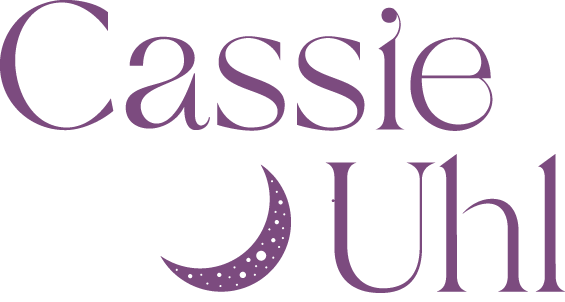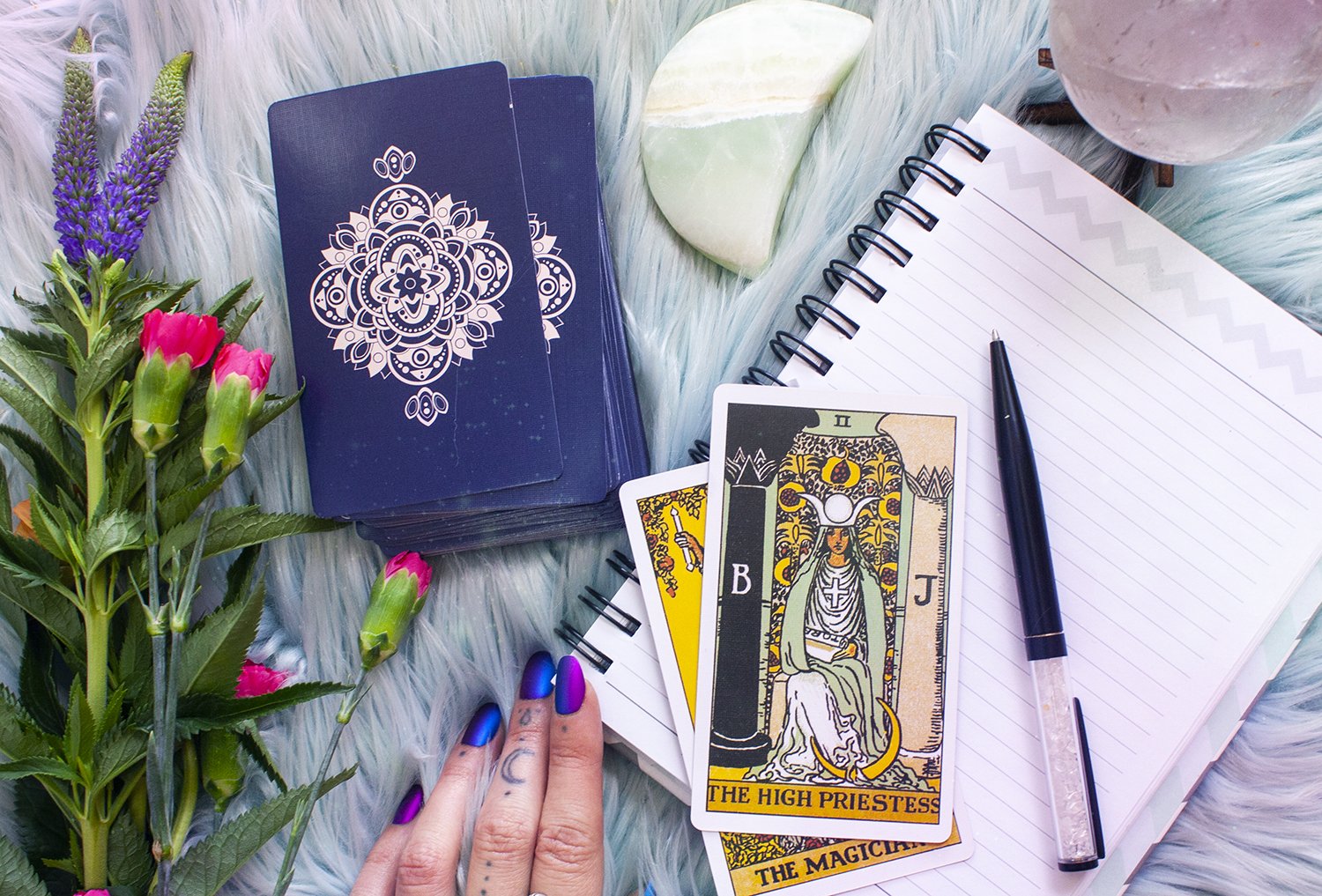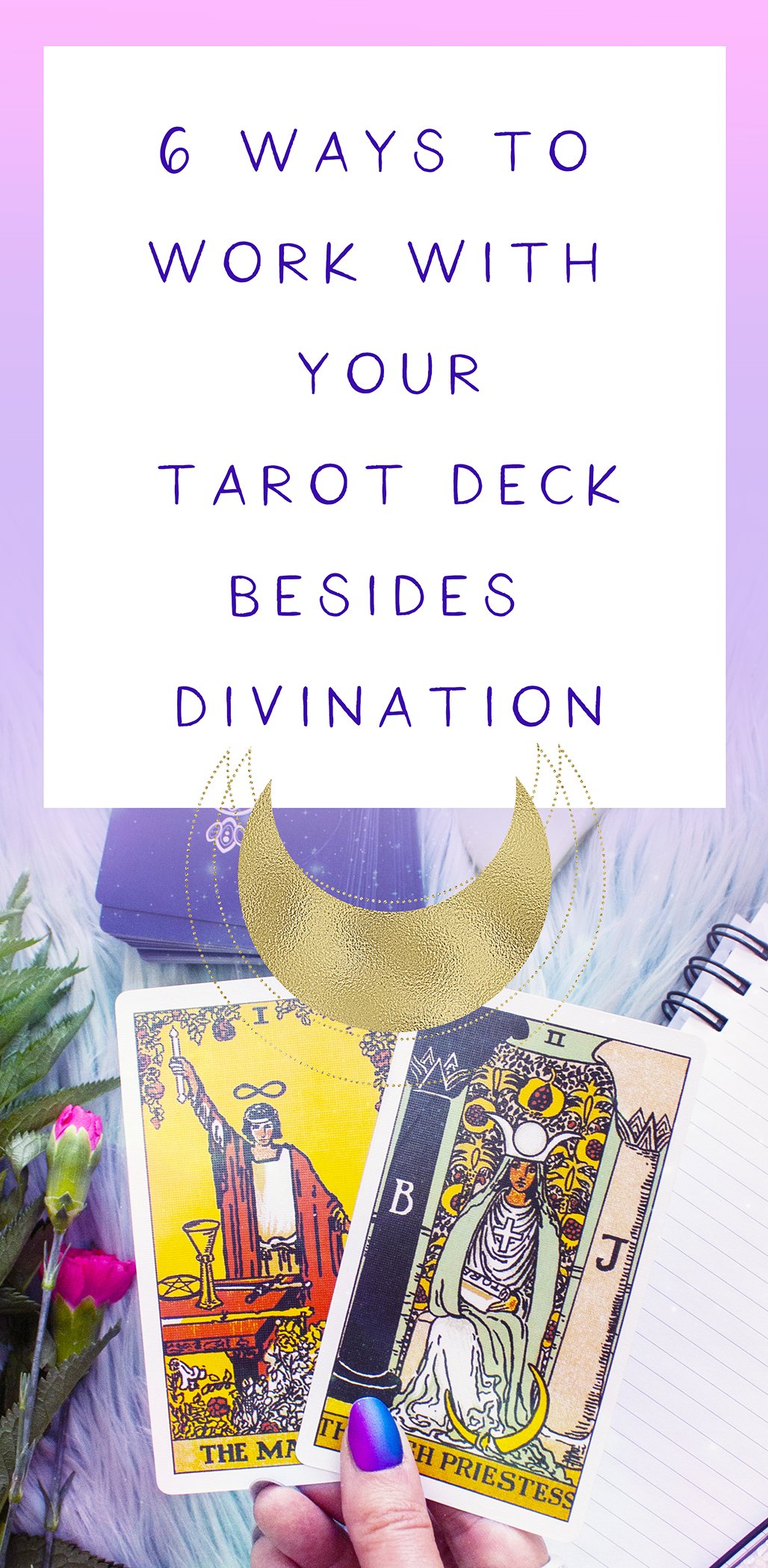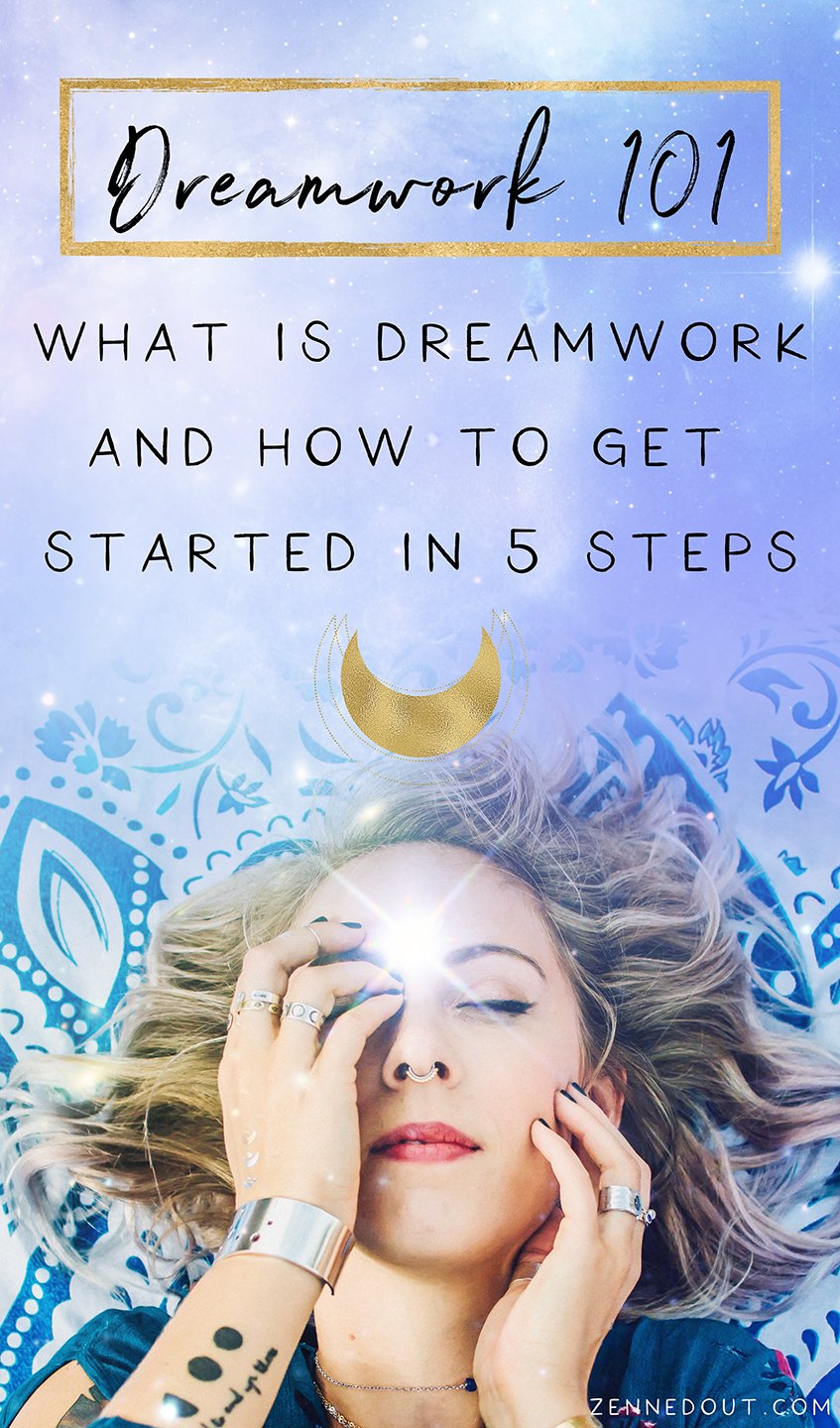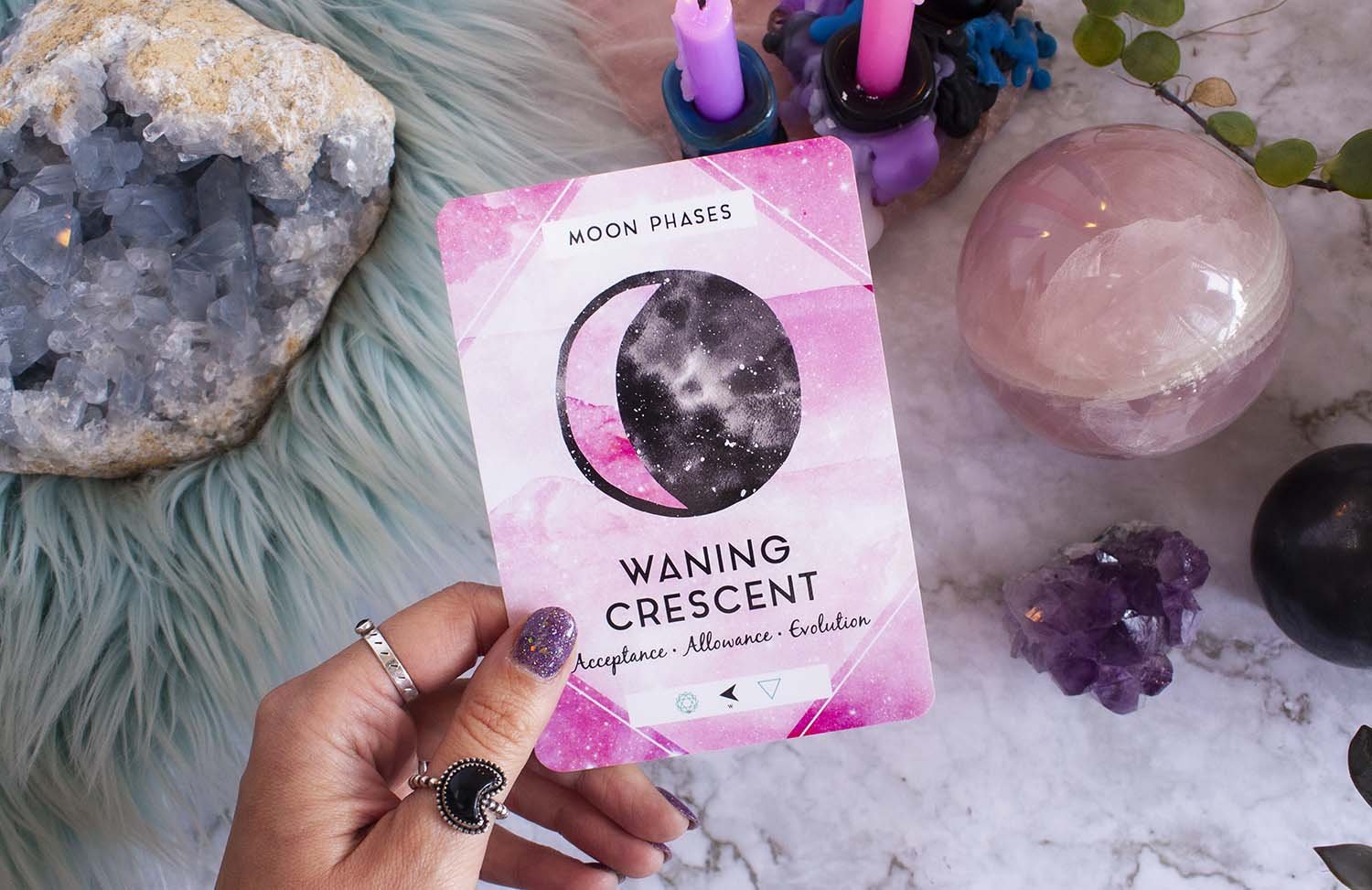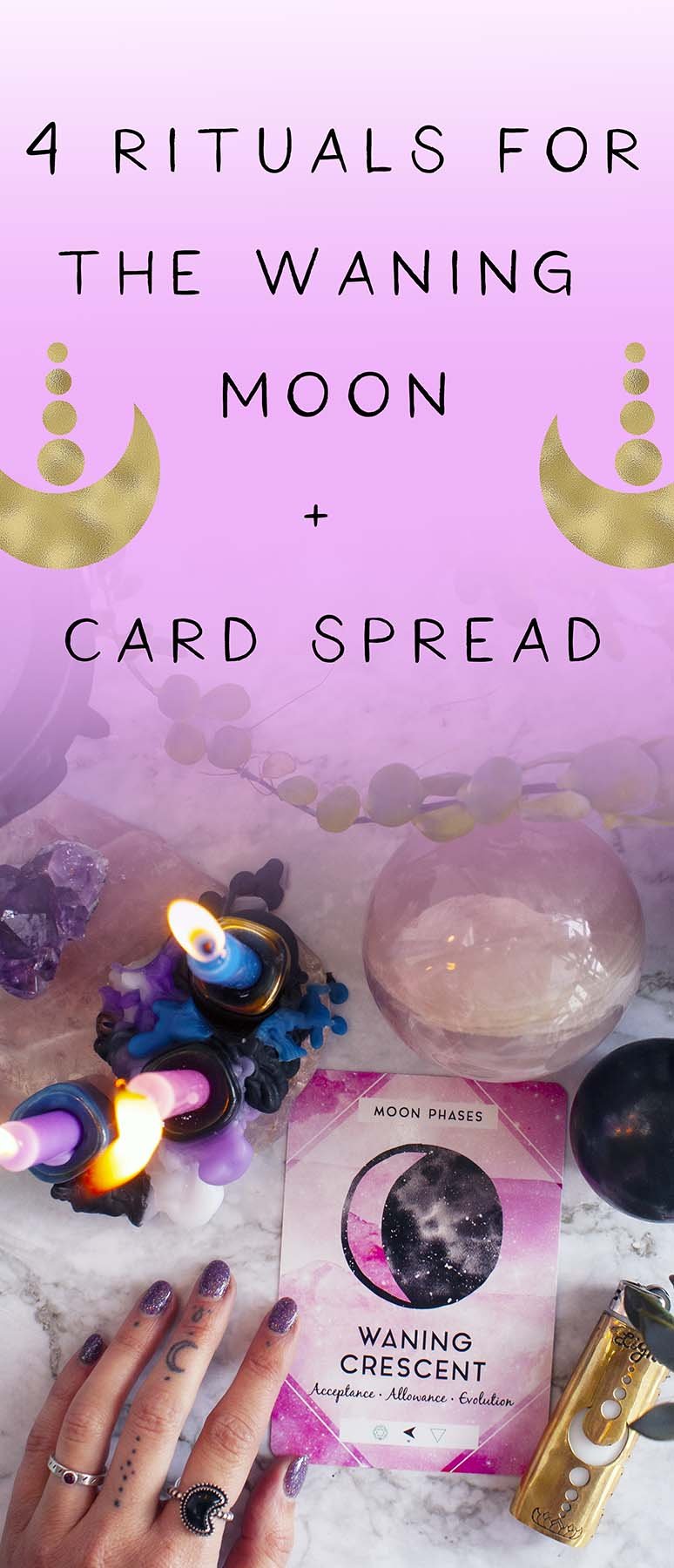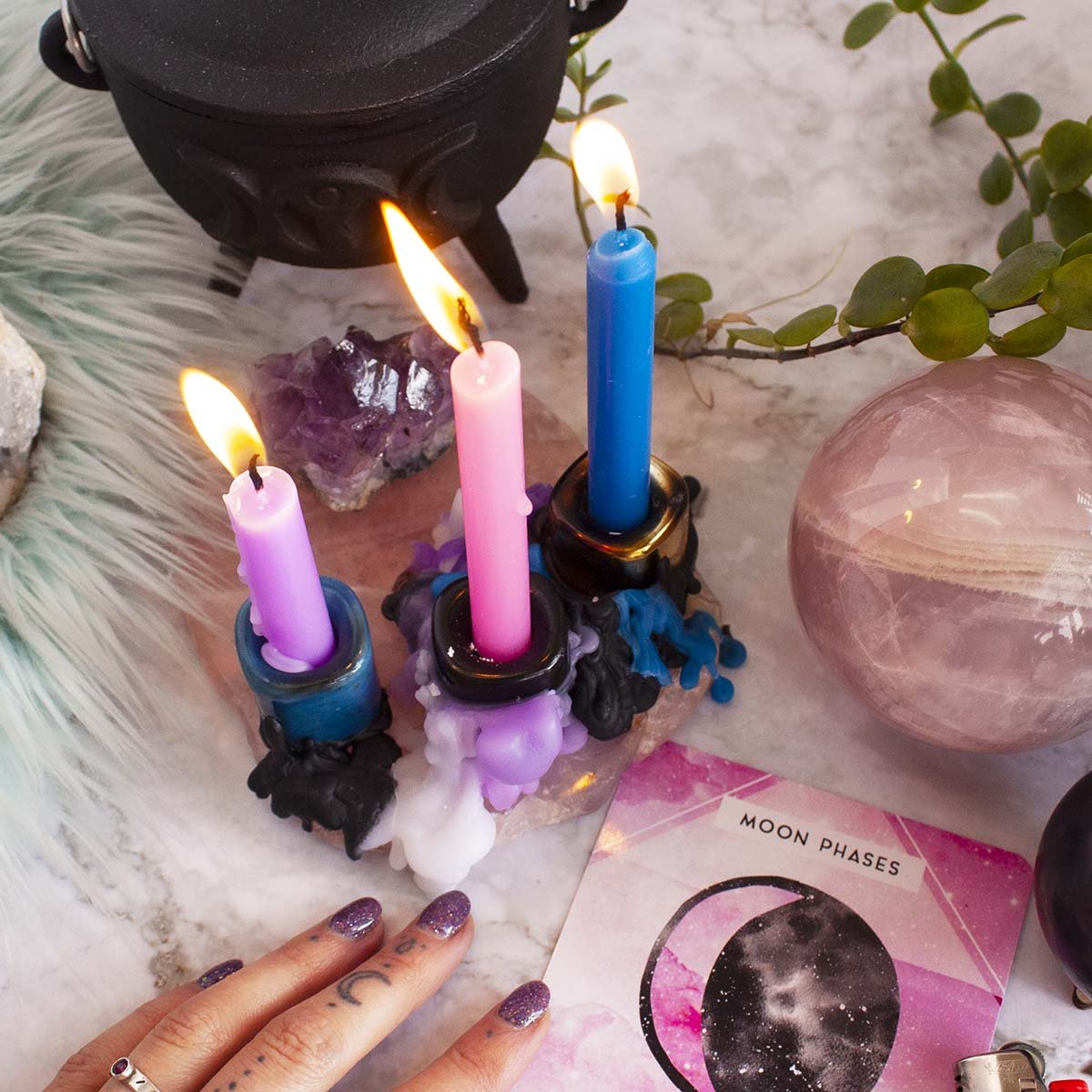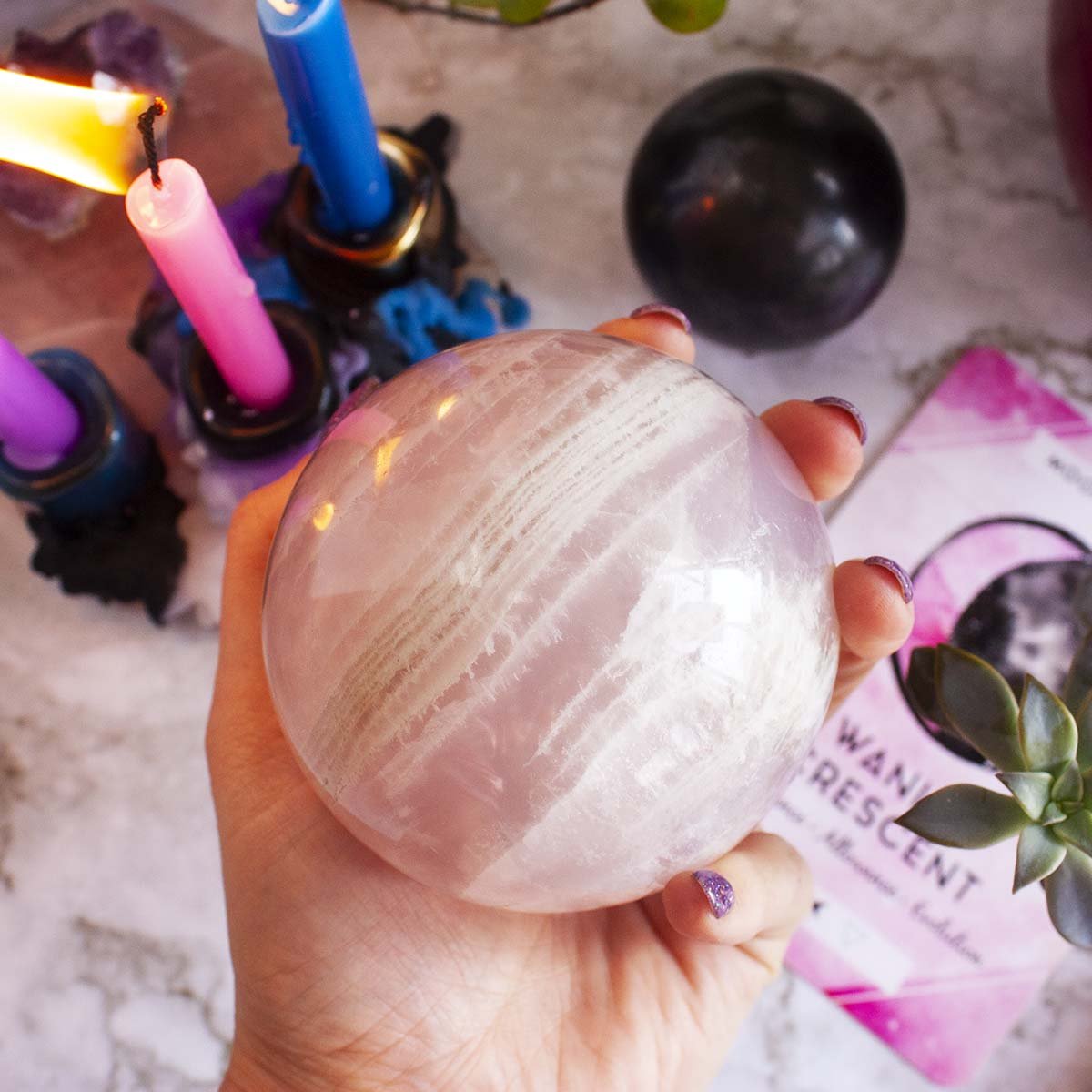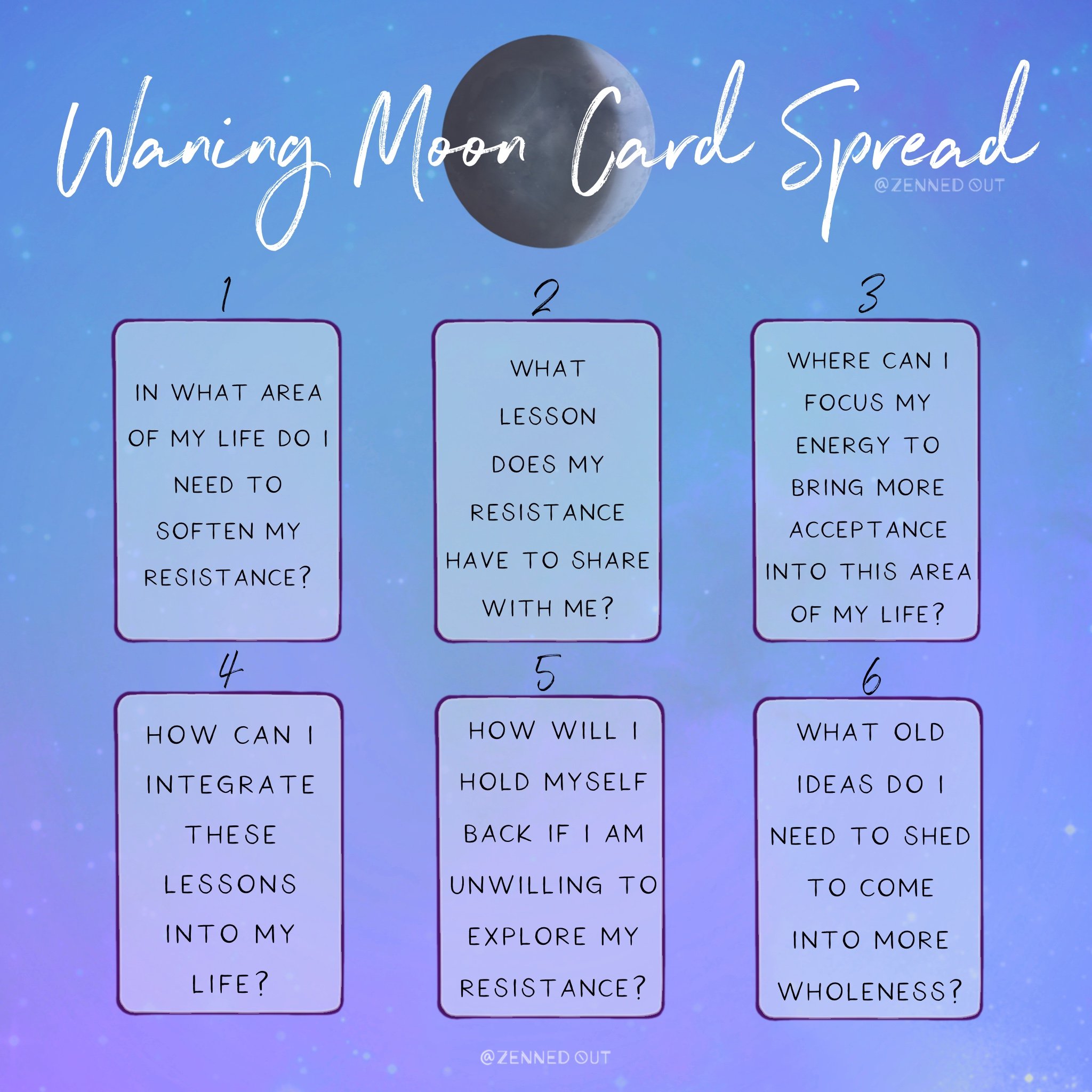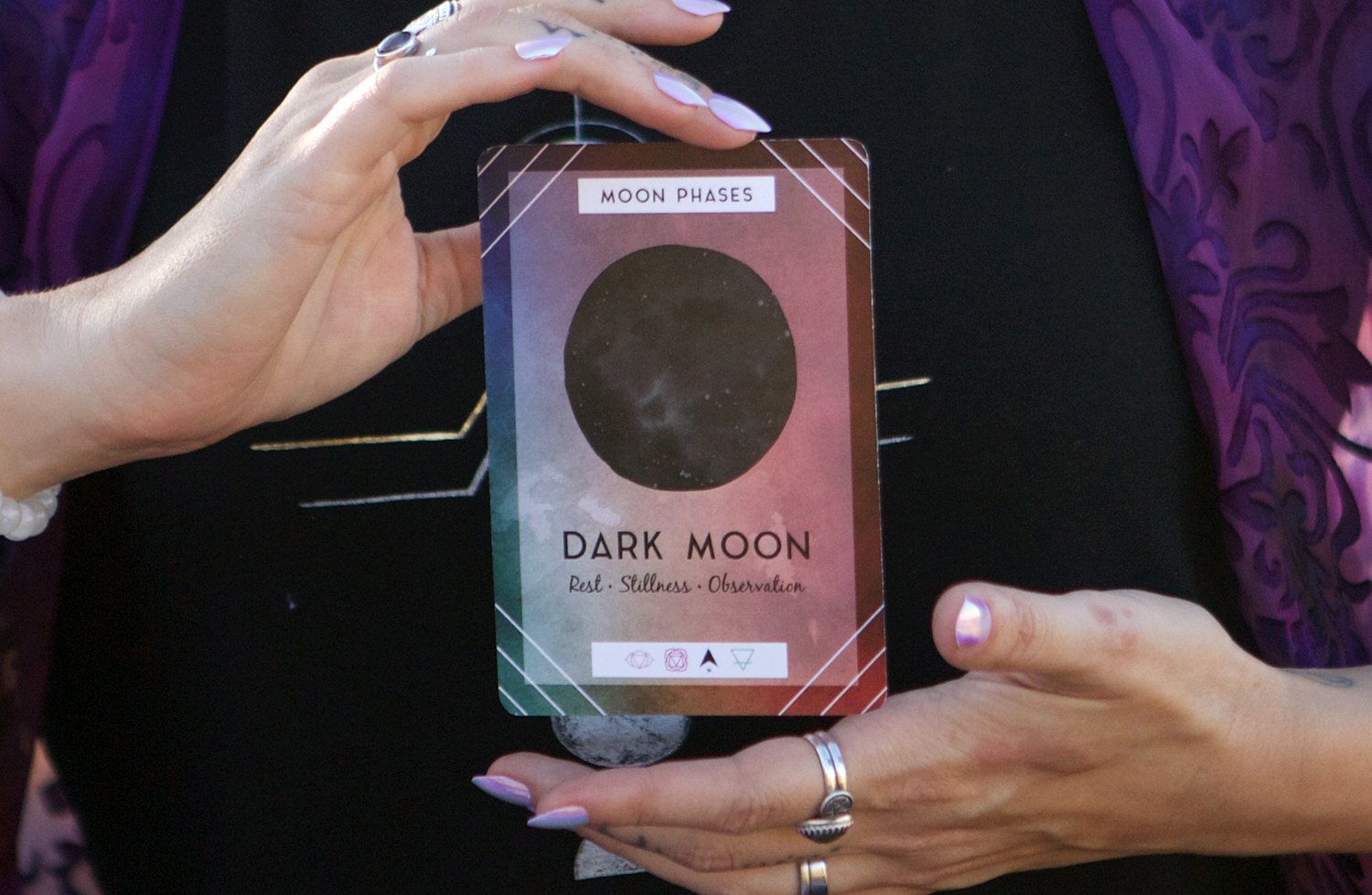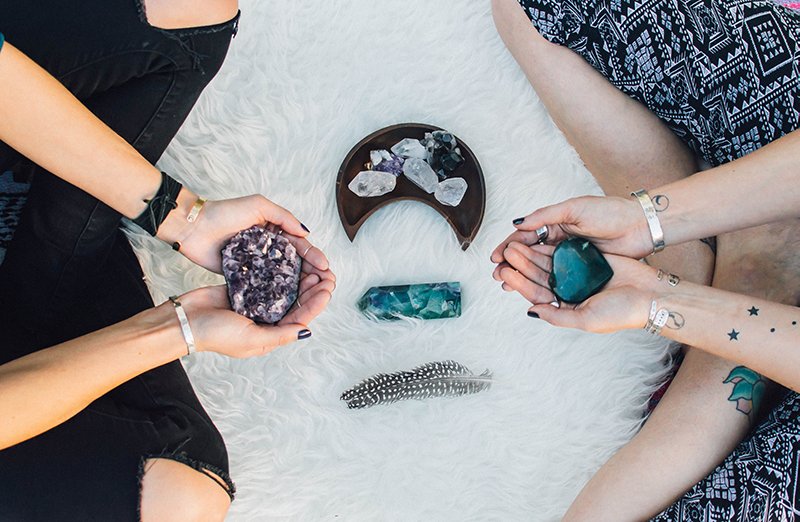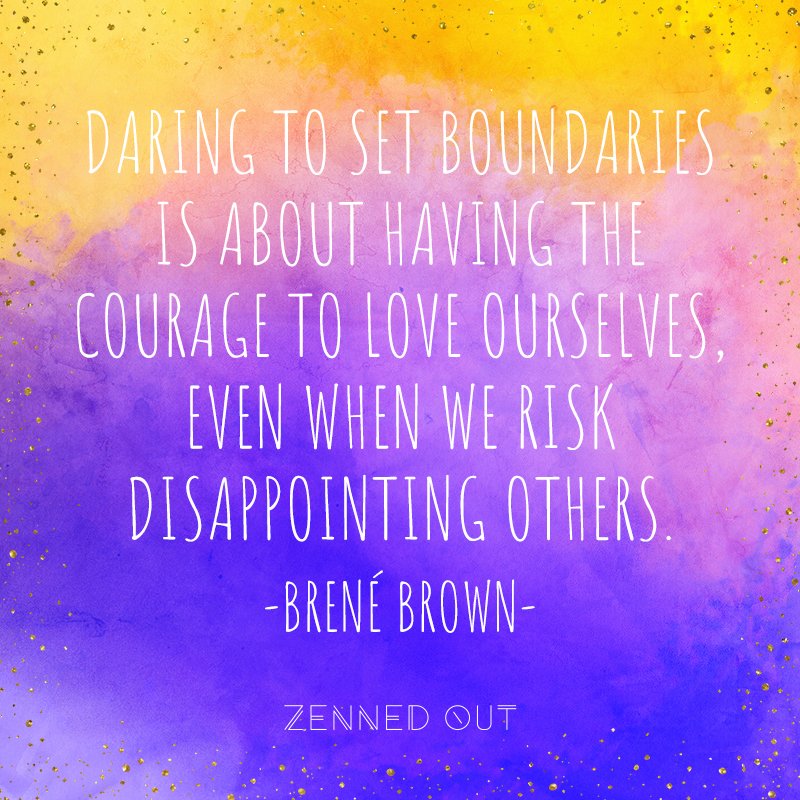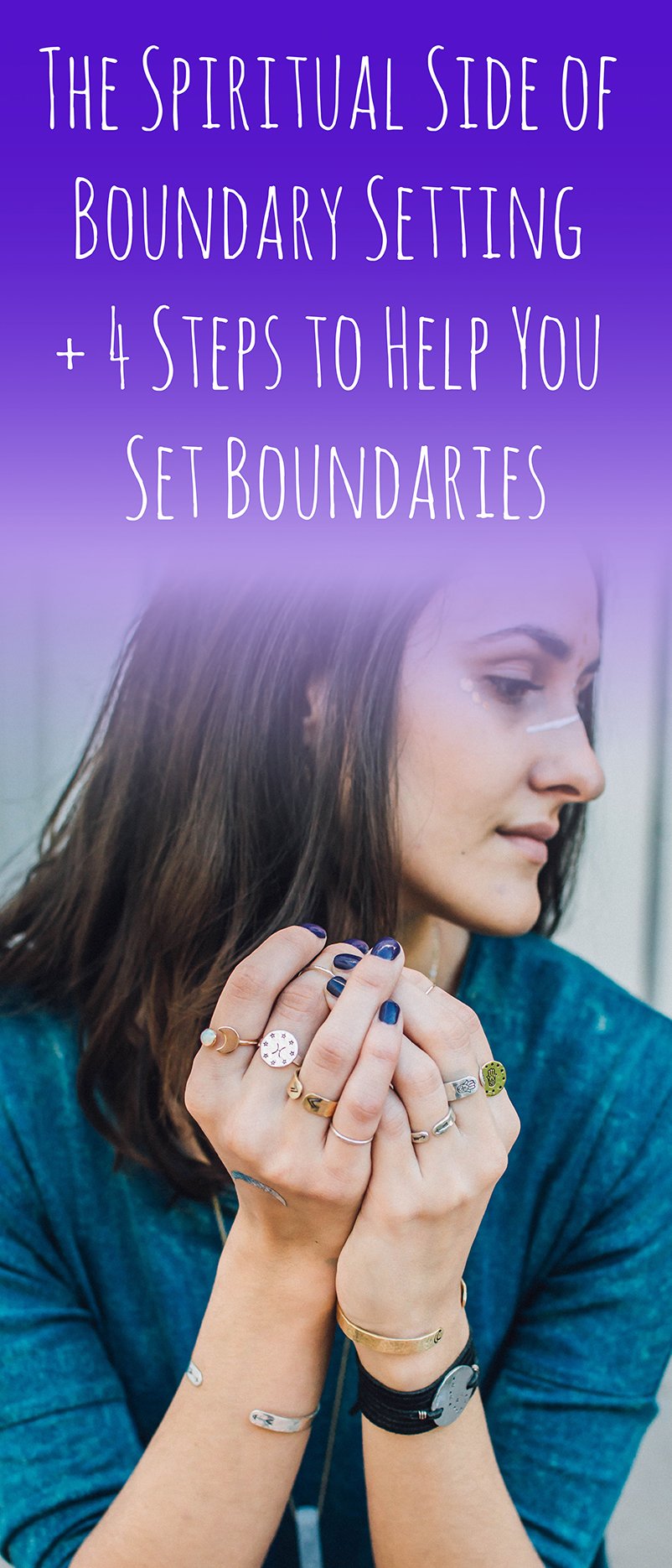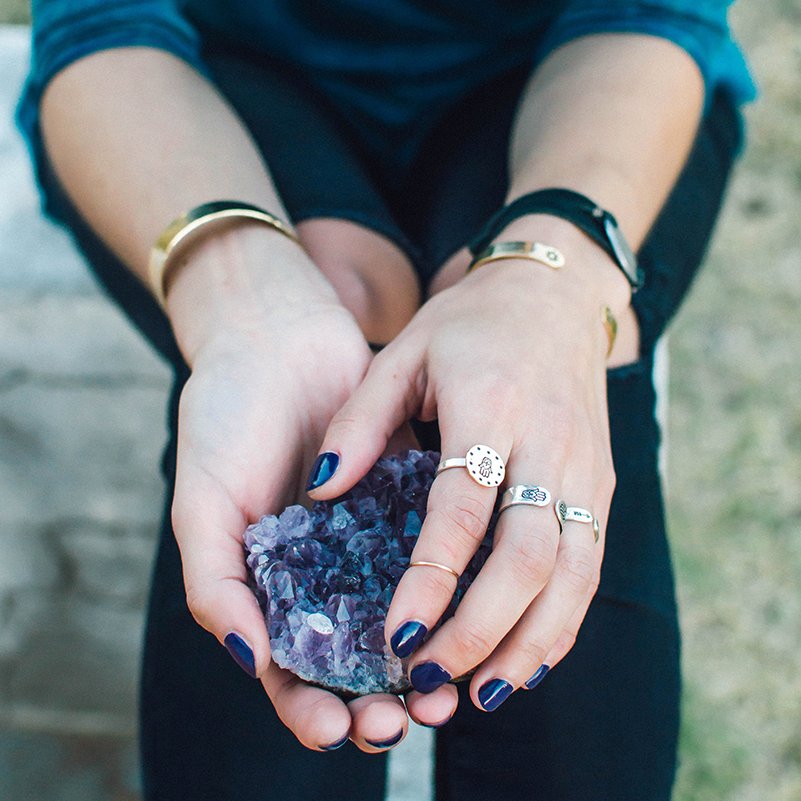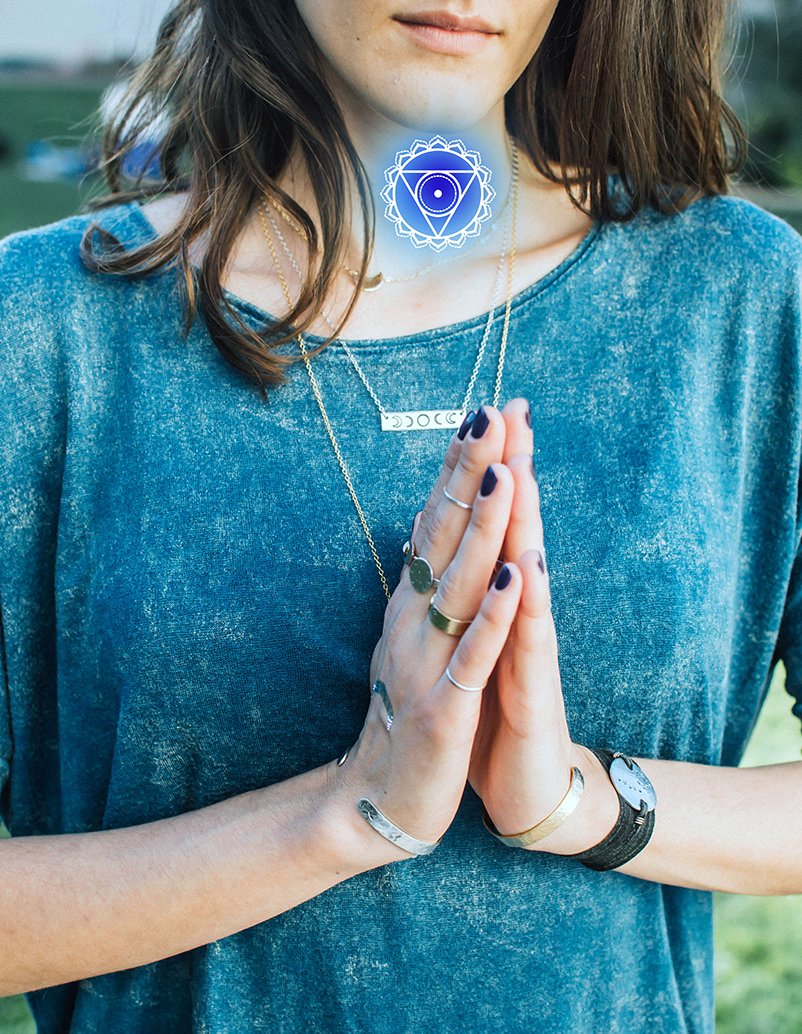A Card Spread for the Winter Solstice
The winter solstice, or Yule, is the year's shortest day and longest night. Yule is a sabbat on the Wheel of the Year that marks midwinter, and even though it’s the darkest time of the whole year, it represents a time of death and rebirth. Here is a card spread to help identify, grieve, and release what’s ready to be shed and reborn within yourself this season.
The winter solstice, or Yule, is the shortest day and longest night of the year. Yule is a sabbat on the Wheel of the Year that marks midwinter, and even though it’s the darkest time of the whole year, it represents a sacred portal of death and rebirth. If you're new to The Wheel of the Year, you can find more about it here.
After Yule, each day begins to get a little more light and a little less dark. It’s a time to celebrate the return of the light.
Yule is associated with evergreen, holly, ivy, mistletoe, red, white, green, gold, and fire. Sounds a little bit like Christmas, right? The pagan holiday of Yule predates Christmas, and when Christianity swept through Europe, Yule's traditions were woven into the Christian holiday of Christmas.
Like many of us witches, pagans, and/or spiritual folks, you may honor both Yule and Christmas.
Keep scrolling to find a tarot or oracle card spread for this Winter Solstice and Yule and other ways you might like to honor this sabbat.
A CARD SPREAD FOR YULE
Take some time to create a ritual space before you pull your cards. Gather a few candles, light some incense or other herbs, and ground yourself before dropping in with your cards. Set an intention for your intuition, your highest self, and/or your spirit guides to communicate with you through the cards.
When you feel ready, shuffle your cards and pull one card for each of the following questions:
What themes are surfacing most prevalently, within and outside of me?
How can I tend to and grieve what wants to surface?
What's ready to pour into the cauldron of the earth this Solstice?
How can I care for myself during this tender time of shedding?
What wants to be reborn, within and outside of me?
Image copyright Cassie Uhl 2023.
Consider sitting with your cards, journaling, and meditating for a while to help you process their medicine and really move the messages through your body.
Some other sweet ways to honor the Winter Solstice and Yule:
Light candles
Gather around a fire with loved ones
Connect with local evergreen trees
Burn pine incense
Meditate on a candle flame or fire
Honor the wisdom of darkness by spending time inside or outside with the darkness of the season.
Create a Yule altar with holly sprigs, pinecones, evergreen branches, and red, green, or white candles and crystals
Find more ideas here
How will you be honoring Yule this year? Let me know on Instagram.
6 Ways to Work With Your Tarot Cards Besides Divination
Divination is a fantastic way to work with the tarot, but you’re selling yourself short with your trusted tarot deck if you’re only using it to glean insights into the future. At its core, and in my opinion, the tarot is a powerful self-reflective tool. It’s here to share insights and guidance about what’s going on with you right now, at this moment. Telling the future is one of the most common draws to tarot, but the tarot truly brings a host of other benefits.Read on for six ways to work with the tarot to grow and expand in new ways, aside from divination.
Divination is a fantastic way to work with the tarot, but you’re selling yourself short with your trusted tarot deck if you’re only using it to glean insights into the future. At its core, and in my opinion, the tarot is a powerful self-reflective tool. It’s here to share insights and guidance about what’s going on with you right now, at this moment. Telling the future is one of the most common draws to tarot, but the tarot truly brings a host of other benefits.
Read on for six ways to work with the tarot to grow and expand in new ways, aside from divination.
Working with Common Archetypes
The tarot is full of common archetypes that you will encounter or embody at different times in your life. Archetypes are timeless and universal energies that people can understand across cultures. For example, the archetype of the mother is something we can all understand on some level. Even if you do not have a relationship with your biological mother or have children of your own, the overarching energy of the archetype of the mother is something you can understand. Furthermore, you do not have to be a mother or a woman to embody the mother's archetype. Anyone can access and learn from the energy of motherhood.
The tarot is dripping with common archetypes, especially in the major arcana. The way the archetypes show up can be personal and vary from person to person. Most of the common archetypes appear in the major arcana, but they can also be found in the minor. Here are some of the archetypes I associate with the cards: the ego (the sun), soul (the moon), mother (empress), father (emperor), wizard (magician), child (the fool), lover (the lovers), martyr (hanged one), seer (hermit), and authoritarian (hierophant), etc. You may decide on different archetypal associations with different cards, and that’s fine.
So, how can you work with the archetypes of the tarot? Lots of ways! You can explore how the archetypal energies associated with the cards make you feel, you can look at the symbology on each card and explore how it makes you feel about its archetype, you can journal about the cards and their archetypal connections, and you can layer it into how you interact with and understand the cards.
Journaling
Journaling allows you to dive deep into the meaning and energy of each card. You’ll better understand the lessons each card wants to offer you through journaling about them. Truth be told, I’m not a big fan of journaling. Journaling with the tarot is different, though. I always write when I pull cards for myself. To begin journaling with the cards, you can work through them one at a time in order or intuitively select a card to journal about. Here are some suggestions for questions to ask yourself when you’re journaling about different cards:
How does this card make me feel?
What symbols or imagery jumps out to me?
Are there any archetypes or human themes that stand out to me in this card?
How does this card show up in my life right now?
What can I learn from this card?
Energy Readings
If you’ve followed my work long, you already know that I love all things energy! We are energy beings, and the tarot is another magical and beautiful way to work with your energy. What do I mean by this? Tarot is an excellent tool for reading your energy and understanding how to balance your energy.
Each card in the tarot corresponds with different energy. When you work with the cards specifically to assess your energy, the cards can act as a guide for what kind of energy you may need more or less of. Each card's energy can act as a signal that you either have too much or too little of that energy.
For example, if you pull some cards to determine what your energy needs to be more balanced and you pull loads of pentacles, that would be a sign that you need more grounding in your life to feel more balanced because the pentacles relate to the element of earth.
You could also consider pulling a card for each energy center or chakra in your body to get an idea of what each energy center needs to be in better balance. I dive into this more in-depth in my book, The Zenned Out Guide to Understanding Tarot.
Exploring and Understanding Common Correspondences
If you’re a visual learner, like I am, you’ll love working with the tarot to understand common correspondences better. I won’t spend too much time talking about this here because I already covered this in a previous post here.
Basically, each of the cards has a handful of correspondences (correspondences are simply energies that match or “play well together.”) The most common correspondences are the elements, astrological energies, and numerology. I’ve found that using the tarot as a tool to understand different types of energies better is immensely helpful, especially for visual learners. The cards' symbology and meanings will add a depth of understanding to your astrology, numerology, or elemental practice. You’ll also learn the tarot card meanings faster as well.
Shadow work
The cards of the tarot contain a complete range of human experiences. It does not gloss over the hard, scary, and sometimes earth-shattering parts of life. This is one reason why, I believe, so many are nervous about diving into tarot. It’s also why it can be such a powerful healing tool.
Your cards will not shield you from your shadow. Instead, they call you to cozy up to your shadow to understand better what it has to teach you. If the idea of shadow work is new to you, check out this previous post to learn more about what shadow work is. Here are a few ways to dive into shadow work using your tarot card deck.
Journal about the cards that make you the most uncomfortable. Use the questions above from the journaling section.
Ask questions specifically to explore your shadow, like “What parts of my shadow need healing and exploring?”, “ What do I have to learn from my shadow?” or “What parts of my shadow have I been avoiding?”
Spellwork & Magick
If you’re a fan of spellwork, altars, or magick, this one’s for you (it’s also another one of my favorite ways to work with my deck.) Because each tarot card carries a unique energy, they are perfect for adding energy and intention to spellwork, magick, and your altar. Here are a couple of ways to start working your cards into your magickal practice.
Place a card on your altar to invite in a specific kind of energy. For example, if you’re focusing on improving your intuition, you could place the moon, the high priestess, or the queen of cups on your altar as a reminder and energetic intention.
Add a card to your spell. For example, if you’re focusing on bringing more abundance into your life, you could include the nine of pentacles or the empress into your spell.
Want to learn more about working with the tarot? Order my book, The Zenned Out Guide to Understanding Tarot. Or, check out some of these posts: Understanding Tarot Correspondences, The Difference Between Tarot and Oracle, 7 Tarot Myths Debunked or Understanding Tarot Birth Cards.
Dreamwork 101 // What is Dreamwork and How to Get Started in 5 Steps
Dreamwork is the practice of tending to our relationship with our dreams. We’re dreaming every night, but many of us barely remember our dreams, or if we do, don’t spend much time thinking about them or working with them.(How often have you dismissed a dream as, “oh, it was just a dream?”)
Dreamwork is the practice of tending to our relationship with our dreams. We’re dreaming every night, but many of us barely remember our dreams, or if we do, don’t spend much time thinking about them or working with them.
(How often have you dismissed a dream as, “oh, it was just a dream?”)
But dreams can have a lot to teach us and offer us when we enter into a deeper relationship with them. The dreamworld is rich with feelings, desires, needs, and possibilities. Our understanding of what the dreamworld evokes and presents can support our physical lives and our connections to ourselves.
In this blog post, I’ll share a bit about how to start a dreamwork practice of your own.
Dreamwork Lineage
First, I’d like to share my dreamwork lineage. What I know about dreamwork comes from the work of these folks in particular, as well as my own intuition and my ancestors:
These are wonderful people to go deeper into dreamwork with if you feel so called.
1. Support Dream Recall + Sleep
The simplest of ways to begin supporting your dreaming is by supporting sleep and dream recall. It’s difficult to consciously work with our dreams if we’re not sleeping well or can’t remember our dreams when we wake up. Everyone is different, but here are some things you might like to explore to support your sleep:
Set screen time boundaries for a certain amount of time before bed
Drink a tea to support your sleep, like chamomile (always do your own research and check with a professional before ingesting herbs)
Create your own sleep ritual that helps you shift into rest mode
Meditate and/or do a gentle, restorative yoga practice
Take a few minutes to journal brain-dump style to help clear your mind.
To support your dream recall, there are a few things I find helpful:
Set an intention to dream and to remember your dream(s) before you go to sleep (you can write this down, say it out loud, or just tell it to yourself silently)
Take a few minutes in bed in the morning before you get out of bed (or look at your phone) to give yourself space to remember your dream.
Create a dream altar and meditate at it before bed to welcome your dreams to come
Pay attention to the dreams you do receive by tending them (more on that below!)
2. Start a Dream Journal
This is probably the number one tip anyone you ask about dreamwork will give you, and with good reason! A dream journal creates a container for tending your dreams, helps solidify your intention to connect with your dreams, and helps you understand your dreams.
I recommend choosing a dedicated journal for your dreamwork and placing it on your dream altar when you’re not using it if you have one. As soon as you wake up (definitely before you look at any devices), put pen to paper and record your dream. Try recording your dreams in the present tense to honor its aliveness (for example, instead of "I was walking by a river,” try “I’m walking by a river).
If it feels available to you, you might like to marinate in the dream in bed for a few minutes before actually getting up and reaching for your journal to record.
3. Explore Dream Feelings & Textures
After you record your dream, there are many ways to work with it more deeply and explore the messages it might have for you.
I like to explore the dream textures: what are the textures, sights, smells, tastes, sounds of the dream? What do those senses mean for you and evoke for you? How do they make you feel? How does the dream, in general, make you feel?
4. Understand Dream Associations
As you work with the dream you’ve recorded, notice what stands out to you. Maybe your red dress feels particularly alive, or the hawk sparks something for you, or you feel curious about a figure in your dream.
Whatever you feel curious about, do a bit of freewriting about it. List out: what does this thing make you think of? How does it make you feel?
For example, some associations that come up with hawks for me:
Hawk feather
Maggie Smith’s poetry book Good Bones
Mothers
Protecting your children
Imagination
Play
Notice how I’m not so focused on the hawk itself, but I follow the threads of what each thing is associated with! Now I have something interesting to work with and can ask myself questions like, "what’s my relationship with play right now?"
Some of the associations you make might really surprise you and can offer deeper insight into your dream.
5. Assign Dream Correspondences
As you continue to work with your dreams, you start to develop some personal symbols and correspondences.
Like you saw above in my example with the hawk, I could make a section in my journal where I note that hawk led me to mothers and children and play. When I see a hawk again in my dream, I have that reference and can ask myself if/how it applies to this dream.
Over time, you can deepen your understanding of your own personal dream symbols and correspondences. I love this practice so much because, to me, it’s not about what a certain symbol means but about what it means to you, how it feels in your body, how it resonates with your ancestry. That’s what feels potent and powerful!
Dreams Aren’t Your Personal Vending Machine
It feels important to state that working with dreams isn’t just asking a question and receiving an answer. Generally, it’s not a simple or linear way of working. There isn’t one true or hidden meaning that we need to uncover.
In my eyes, dreams and the dreamworld are alive. So it truly is a practice of engaging in relationship with, of exploring. You might like to ask yourself, "how can I be in equal exchange with my dreams?" How can I honor the dream world and not just extract from it?
Dreams have such potential to expand us out of binary thinking and into visionary possibilities, especially if we acknowledge that power and allow them to take us there!
Going Deeper with Your Dreams
Another way to explore dream tending and go a bit deeper is by asking for a dream. I share how to do this in the dreamwork ritual I shared for Pisces season, which you can find here.
Feel free to contact us and share: how is your dream practice going? How is your relationship with your dreams evolving?
Sinking into acceptance // 4 Rituals for the Waning Moon + Card Spread
The waning moon phase is nature's way of calling you inward. How can you truly know what you need to release, shed, or let go of if you haven't allowed yourself time to go inward and fully experience your emotions? This phase is your invitation to feel and allow.The waning moon phases occur after the peak of the full moon to the dark moon. Energetically this phase represents a time of allowance, acceptance, and shedding.
The waning moon phase is nature's way of calling you inward. How can you truly know what you need to release, shed, or let go of if you haven't allowed yourself time to go inward and fully experience your emotions? This phase is your invitation to feel and allow.
The waning moon phases occur after the peak of the full moon to the dark moon. Energetically this phase represents a time of allowance, acceptance, and shedding.
Growing up, most of us are taught to bottle our feelings up rather than sinking into them and accepting what is. Acceptance doesn't mean rolling over and taking it or being okay with the status quo. Not by a long shot. Acceptance of the current moment means allowing yourself to fully experience whatever is bubbling up in you at the present moment.
If things in your life, or the world at large, are not aligned with your desires and want them to change, you don't have to accept them as they are. What you do need to accept is your feelings about these situations. It's in the allowance and acceptance of situations that healing, growth, and change can occur.
There's an opportunity to grow from every situation you're presented with, and this phase asks you to be open to the learning and evolving process rather than pushing against it. Imagine the energy of this lunar cycle as a big unconditional and loving hug.
Here are a few keywords to understand the basic energy of this lunar phase.
Energetic Themes for the Waning Moon
Passiveness
Acceptance
Allowance
Releasing
Shedding
Resting
The rituals outlined below will work well together, but if you don't have the time or tools to perform all of them at once, that's okay, do what feels most aligned with your needs. Keep reading for four ritual suggestions for the waning moon phase.
1. Candle Ritual for the Waning Moon
Candles are an ideal ritual tool for this moon phase because they can be used as a very passive tool. I suggest using this candle ritual suggestion in tandem with one of the ritual suggestions below so your candle can burn as you sink into a ritual. There's more than one candle color that will work for this lunar phase, here are three suggestions, go with what feels best for where you're at, or use all three!
Pink candle: Pink candles offer soft and loving energy. This candle color is ideal for bringing in self-love and acceptance. This candle color is often suggested during the waxing moon phase to call in romantic love. For the waning moon phase, its energy will be used as a tool to call in self-love.
Blue Candle: Blue candles offer peace and respite. If you've been in a cycle of overwhelm and feel like you can't catch a break, this is your candle. The energy of this candle can help you soften into the present moment to access your emotions better.
Purple Candle: Purple candles offer inner wisdom and perspective. If you're in a place of allowance with your emotions but struggling with accepting them, the energy of a purple candle can help open you up to a higher perspective and shed light on why you feel the way you do.
If candle magick is new to you, and you'd like to learn more about how it works and the process I outline here, check out this past blog post on candle magick basics.
Once you've selected your candle color(s), you may want to anoint your candle with a specific oil. I suggest lavender, bergamot, rose, or geranium work well with the energy of the waning moon. If you don't have any of these available, a simple carrier oil, like almond or coconut oil, will work just fine.
Anoint your candle with your oil, hold it in your hands, and impress it with your energy. Repeat this intention or something like it that feels good to you, "I love and accept myself as I am. I am allowed to feel the fullness of my emotions and will let them flow through me. I trust that Spirit will show me what needs to stay and what needs to go. So it is."Light your candle(s) and stay with it as it burns.
2. Waning Moon Meditation
If you're going to do any of these waning moon rituals, meditation is my top suggestion. I covered this topic in-depth in a previous post, so I'm not going to spend too much time discussing it here. But, if you've followed me for long, you know that I adore meditation.
Meditation opens you up to your inner world, which is step one in allowance and acceptance. As I said above, you have to take the time to explore your inner landscape before you can truly know what needs to be released. Meditation and internal reflection is the first step in this process.
Click here to get my free waning moon meditation or here to read my previous blog post on meditating with each moon phase.
If you'd like to add some supportive crystals to your waning moon meditation, I suggest rose quartz and a grounding stone of choice like obsidian, black tourmaline, or garnet.
3. Waning Moon Card Spread
Use this card spread with your favorite oracle or tarot card deck. These questions can offer guidance on finding more acceptance in your life and suggestions for releasing anything holding you back from your highest good.
If you didn't begin with the candle ritual or meditation suggestion above, take a moment to connect with your breath and ground yourself.
In what area of my life do I need to soften my resistance?
What lesson does my resistance have to share with me?
Where can I focus my energy to bring more acceptance into this area of my life?
How can I integrate these lessons into my life?
How will I hold myself back if I am unwilling to explore my resistance?
What old ideas do I need to shed to come into more wholeness?
Be open and honest as your cards reveal guidance to you. The next ritual can help you uncover any confusion you may have about your reading. If your reading is initially unclear, leave it, be open to signs from Spirit, and revisit it at a later time.
4. Write and Release
This ritual suggestion works well after performing either the waning moon meditation or waning moon card spread because you should be fresh with emotion and insight. Take some time to write about what came up for you. Alternatively, if tarot and oracle cards aren't your thing, you can use the card reading questions above as journal prompts.
Writing is a powerful tool for exploring, feeling, processing, and releasing your emotions. Here's a conclusion from a study conducted on the healing benefits of writing: "There is power in written expression and the personal sharing of one's story. Writing shows promise not only as a therapeutic tool during intervention, but as an ongoing avocational activity with many personal and health benefits."
Try to write without judging what you're writing and let your thoughts and feelings flow.
Choose to release your writing in a way that feels good to you. You can burn the paper in a fire-proof vessel, bury your text in the earth, release it into a flower body of water (ensure that your paper is compostable if you do this method!), or something else that feels good to you. You cannot do wrong; the purpose of all ritual is to bring meaning and healing to your experience, so trust that the releasing method you select is what will serve you best.
I hope you feel empowered to love and accept yourself fully, emotions, and all. Dance with all aspects of your being. Know that in each moment, even the uncomfortable ones, there is an opportunity to go deeper and find wholeness.
How to Get Started with Spiritual Activism
If you’re reading this, you probably have a desire to make the world a better place. But you may feel like you’re not sure how to go about it in a way that aligns with your spiritual practice and values.Your spiritual practice and your activism aren’t separate, they’re one. They can be, and I think they should be— because the world needs you, as an activist, to show up as a spiritual being...and as a spiritual being, to show up as an activist.
If you’re reading this, you probably have a desire to make the world a better place. But you may feel like you’re not sure how to go about it in a way that aligns with your spiritual practice and values.
Your spiritual practice and your activism aren’t separate, they’re one. They can be, and I think they should be— because the world needs you, as an activist, to show up as a spiritual being...and as a spiritual being, to show up as an activist.
This means that not only are we meditating on healing the world, manifesting collective healing, and whatever other healing practices you have…but we’re also bringing that work into how we show up in the world as agents for change. We show up as our whole, spiritual selves when we call our senators and representatives. When we march, when we protest, when we volunteer, when we donate, when we organize, when we listen, when we post on social media.
That is spiritual activism.
COMPASSION
One really important piece of spiritual activism is compassion for yourself and for others. It’s really easy and often justified, to get caught up in your feelings and forget that the person you’re engaging with is also a human being. A human being who may be really offending you right now, but still a human being.
Remember that your feelings are justified. And of course, you don’t have to continue to engage with someone who is hurting you. But remembering some of the truths that are likely part of your spiritual practice, like compassion for all and the idea that at the core of it, we are all one, is just as important in these situations as it is in others.
ANGER
Ask yourself:
How do I want to feel?
How do I want others to feel around me?
List these answers out, and think about how they apply to your activism. If you want to feel inspired, open, safe, joyful, free, loved, whatever it is — you probably want other people to feel that way around you, too.
How can you approach your activism in a way that holds space for that? How can you approach your activism in a way that makes yourself and the people around you feel that way the majority of the time?
A note about anger: you probably want to create change around two things: things that break your heart, and things that make you angry. In some dialogue about spirituality, anger is bad. It’s something to be stifled and ignored.
But anger is human, and I think the only thing that makes it bad is repressing it. You’re going to be angry about injustice. It’s what we do with our anger, how we express it, and how we channel it that can help or hurt us.
So instead of repressing your anger or using it to lash out at people, I invite you to channel your anger into productive change, remembering that compassion and anger aren’t mutually exclusive.
START WITH YOU
When it comes to activism, start with you. It can be hard to wrap your head around at first but understand that you are not separate from the problem. You are not separate from these oppressive systems.
As a white person, racism isn’t about someone else. It’s about me.
As a cisgendered person, violence against transgender people isn’t about someone else, it’s about me.
The list goes on.
Ask yourself: in what systems am I an oppressor?
You can be oppressed in certain systems, like gender, and be the oppressor in others, like race.
This is where we get into the idea of privilege.None of this is about berating yourself for being a bad person or being complicit in these systems. You’re not a bad person! But the point of this being the first step is that when we know better, we do better. But we can’t do better if we don’t immerse ourselves in the “know better” step first.
Ask yourself: what privileges do I hold?
(Ideas: able-bodied privilege, white privilege, cisgendered privilege, straight privilege, thin privilege, in your country legally, etc.)
Take some time to really think about how those privileges manifest in your life and how they’ve become systems of belief. For example, what beliefs have you absorbed about people who don’t hold the privilege of being documented, or who don’t hold thin privilege?
What can you do to root down, shift those beliefs (which always manifest into actions even if you may not realize it!), and create more equality in your own life?
How is this spiritual activism? I think it comes back to the idea that healing yourself is healing for the world. I think most of us can probably get behind that. In this sense, cleaning up your own baggage, the ways in which your hurt and oppress is the most important thing we can do.
RELEASE
These days in this political climate I think it’s really important to have an embodiment practice to help you release trauma, anger, and other emotions you’re storing up from your cells. Tapping, breathwork, and a good old-fashioned scream are great ways to release.The practice can look like anything you need it to, but choose something that’s a physical release.
How to journal with the moon phases + 10 journal prompts
Your mood, physical body, and spirit body all go through phases, and journaling with the moon is an ideal way to track all of these. You may find that you’re more synced with the moon than you thought!
Your mood, physical body, and spirit body all go through phases, and journaling with the moon is an ideal way to track all of these. You may find that you’re more synced with the moon than you thought!
Why You Should Try Moon Journaling
Wouldn’t it be nice to know which moon phases make you feel the most intuitive, expressive, or reserved? The way you relate to each moon phase is reflective of you alone and experiences will vary from person to person. You may find that your diet, intuition, and menstruation are affected by the phases of the moon. Keeping a moon journal will enable you to track any patterns to better understand all of your cycles.
How Often Should You Write in Your Moon Journal?
Take notes in your moon journal as often as you like! Journaling once a week will ensure that you hit each of the main phases of the moon: new moon, waxing moon, full moon, and waning moon. Moon journaling twice a month, on the full and new moon, can also be enlightening.
Starting out, I suggest making a quick note in your moon journal for 30-60 consecutive days. Making a quick note daily, in the beginning, will help you catch any obvious patterns right away.
What You’ll Need to Start Your Moon Journal
You’ll need a moon phase calendar, digital, or a hard copy.
You’ll also need a writing utensil and a journal or notepad. That’s it!
10 Topics for Moon Journaling
Here’s a list of suggested moon journaling topics. Read through the whole list. What topics call out to you the most? You can journal on all or some of these topics, it’s completely up to you.
Start your moon journaling by recording the date, the moon phase, and the zodiac sign for the phase (optional).
Record how you feel emotionally. Check-in, do you feel content, happy, sad, jealous, excited, energized, grateful, anxious, or angry? Record your mood for the day or overall week. This can be as simple as writing one word.
Record how you feel spiritually. How connected and intuitive do you feel? If you meditate regularly, was it easy for you to “drop-in” or did you find your meditation to be a struggle (this is always a good indicator of my spiritual well-being).
Record how you feel physically. How are you sleeping, your energy levels, and your diet? Are there any particular foods you're craving? If you exercise regularly, was your activity easy or more forced?
Record when you start and end your menstrual cycle. You may also decide to notate what each menstrual cycle feels like to help unearth patterns. If you’re particularly in-tune with your cycle or trying to conceive (or not conceive!) you might also find it helpful to track your ovulation with the moon.
Note any goals, intentions, and manifestations you’ve initiated and when they manifest. New intentions are best to set on a new or waxing moon.
Note any habits, people, outcomes, or things you’re trying to let go of and when you feel you’ve shed them. Releasing and letting go is best to initiate during a full or waning moon.
Notate the zodiac sign the moon is in. If you want to take your moon journaling to the next level you can notate what zodiac sign the moon is in. The moon is always positioned in a zodiac sign and cycles through them every 2-3 days. The sign the moon is in will also have an effect on you too. Try looking for even broader patterns by notating what sign the moon is in when you journal. I like this online resource for tracking the zodiac sign for each moon phase.
Track your triumphs! Did something happen that was totally out of the blue and made your day? Maybe you received an unexpected promotion, landed your dream job, or ran into an old friend, write it down!
Track your worst days. Did you have one of those days where nothing seems to go as expected and you just can’t shake it? These days aren’t as fun, but being able to estimate when they may come up can sure be helpful.
Note your dreams. Dream journaling is an insightful activity on its own. Notating the moon phase for your dreams can shed even more light on what your subconscious is trying to tell you. You might be able to identify times when your dreams are most active so you can plan to have a notepad ready on your nightstand.
Moon journaling can be as simple or in-depth as you’d like and can be tailored to suit your needs and schedule.
The Spiritual Side of Boundary Setting + 4 Steps to Help You Set Boundaries
Many of us, especially women, have been taught to give and give and give without question. Over time, as you probably know, this becomes exhausting and depleting. You might already have strong boundaries, or maybe you’re realizing just now that you really need to set them, but you’re afraid. If you’ve been waiting for a permission slip to create more boundaries in your life, consider this it.You are a powerful being, and you get to decide what is and is not acceptable to you in your life…
Many of us, especially women, have been taught to give and give and give without question. Over time, as you probably know, this becomes exhausting and depleting. You might already have strong boundaries, or maybe you’re realizing just now that you really need to set them, but you’re afraid. If you’ve been waiting for a permission slip to create more boundaries in your life, consider this it.
You are a powerful being, and you get to decide what is and is not acceptable to you in your life (if reading that gave you a strong reaction, check out this post for tips to connect with your authentic power). You are allowed to take up space. You are allowed to speak up and stand up for yourself. This is the spiritual work of boundary setting.
Boundaries are an important way of setting the terms for how it is and isn’t okay for other people to interact with you, and on an energetic level, they’re a way of protecting your own energy.
Because spiritual work isn’t all pretty all the time. Sometimes it’s the deep, unglamorous work of digging into the roots of your heart and seeing what you truly need, and then telling people that no, you won’t answer their DMs, or no, you won’t do free work anymore, or no, you can’t hold energetic support for them at this moment because you simply have nothing left to give.
I saw Gabby Bernstein live last year, and during the Q&A portion of the night a woman went up to the mic and told Gabby that she was feeling so spiritual these days— so spiritual, in fact, that all she wanted to do was lock herself in her room and meditate and read spiritual books. She said she was starting to resent her life— her kids, her work, her husband— for taking her out of that.
Gabby said, “Here’s what you don’t yet understand: your life is your spiritual practice.”
That’s always stood out to me. Meditating, ritual, yoga, tarot, all of the things we love— they can all be part of your spiritual practice. But they’re not THE spiritual practice. Your spiritual practice is how you treat people, how you treat yourself, how you move in the world, how you set boundaries.
And since we’re always evolving and growing, our boundaries are always evolving, too.
Scroll down for some tips on how to set clear boundaries.
Figure out what your boundaries are
How do you know which boundaries need to be set? How do you know when a boundary has been violated?
Practice checking in with your feelings. Boundary violations may manifest as making you feel powerless, confused, drained, disassociated, angry, or upset. When you feel that way, take an honest look and ask yourself why?
Did someone treat you in a way that’s unacceptable to you? Did you perform free emotional labor that’s leaving you drained? Are you speaking to yourself in a way that’s hurtful?
Dig in and look at why you may struggle to set boundaries
Try these journaling questions:
What did I learn as a child about the importance of being liked, going with the flow, and saying yes?
What did I learn as a child about saying and hearing “no?”
What am I afraid will happen if I set and stick with clear boundaries?
Open your throat chakra
The state of your throat chakra is heavily associated with your ability to set and communicate clear boundaries. When your throat chakra is blocked, you might be afraid to stand up for yourself and be seen or fear being judged for the boundaries you set. Get seven ways to balance your throat chakra here.
Communicate clearly
Once you’ve done the work in steps 1-3, this step should come more easily. Just remember when you’re communicating your boundaries to stand firm. You can speak your boundaries with love and compassion without apologizing, feeling guilty, or making them feel optional. Be as clear, honest, and direct as you can.
Remember, you have to set that boundary clearly with yourself before you can communicate it to anyone else.
You’ve heard it before but I’ll say it again: saying no creates the space for your big YES to come in—whether that’s relationships with people who treat you well, a job that fulfills your soul, or something else. Setting boundaries aren’t just about saying no, it’s about saying YES to only the things that feel good to you and light your soul up.
What’s your relationship with boundary setting? Now’s a perfect time to take a look!
Cord Cutting a Ritual for Letting Go
What are you holding onto right now that you’re afraid to let go of? Is it a career that you thought was your life’s calling, something hurtful someone said to you, a relationship gone south, or your lack of control over a situation?If you haven’t already been faced with one of these “letting go” hurdles, it’s likely you will at some point. The need to let go comes in all shapes and sizes throughout life and might be some of the hardest tasks you’ll face.
What are you holding onto right now that you’re afraid to let go of? Is it a career that you thought was your life’s calling, something hurtful someone said to you, a relationship gone south, or your lack of control over a situation?
If you haven’t already been faced with one of these “letting go” hurdles, it’s likely you will at some point. The need to let go comes in all shapes and sizes throughout life and might be some of the hardest tasks you’ll face.
Why is it important to let go?
Holding on can take up a lot of unnecessary headspaces, leaving you anywhere but in the present moment. When you’re afraid to let go, it’s usually your ego that’s in control, and no one wants that! Refusing to let go means you’re also refusing to trust that you’ll be taken care of and that the universe does have a plan for you.
This week I’m breaking out my favorite ways to help you let go of whatever it is that’s holding you back from your highest potential. These rituals can be done on separate days or all together as one big ritual, your choice! Let’s get started.
Step 1: Burn Baby, Burn
Time to get out your candles and cauldron. The first step is to recognize what it is that you’re trying to let go of and become willing to work on it. A burning ritual can help make this decision more concrete for you.
You’ll need:
Black and white candle. The white candle is for protective loving light and black candle is to help absorb negative energy, but any candle will work if you don’t have these colors available. Click here to learn more about candle magick.
Pen and paper
Cauldron or other fireproof vessels
Optional: Frankincense EO or incense. Frankincense will help you center yourself and let go. I like using Plant Guru’s Meditation blend.
The best moon phase to perform this ritual is during a waning moon. Set aside some quiet time, and center yourself with as many deep breaths as you need to feel calm and present.
To get started, light both of your candles and incense, if you’re using it. Write what you need to let go of on a piece of paper. Light the paper with the flame of each candle and place it in your fireproof vessel. Watch and breathe as your paper burns, allow any feelings you have to come to the surface. This is also a great time to call upon any angels, deities, or energy you’d like to invite in to help you through this process.
When you feel like this part of the ritual is complete, thank any spiritual energies that you invited in and blow out your candles. You can leave this setup and the ashes of your burned paper out as long as you’d like as a reminder.
Step 2: Cord-Cutting Ceremony
This is my personal favorite ritual for letting go. I discovered it from The Goddess Oracle by Amy Sophia Marashinsky and is the suggested ritual when you receive the Lilith Goddess card.
You’ll need:
String. Must be strong enough to be worn for a long period of time.
Scissors
Candles, incense, EO (optional and can be the same as above)
This ceremony should also be performed during a waning moon. it blends well into the first ritual and I recommend performing them in tandem, though they do not have to be. If you do start this ceremony separately from the above one, be sure to set aside time to quiet your mind and center yourself.
To begin this ritual, start by deciding where your cord should be tied on your body. You’ll want to tie the string somewhere that connects with what you’re letting go of. If what you’re letting go of has something to do with work and you use your hands you might decide to tie it around your wrist, if you’re walking away from something you could tie it around your ankle, if it has something to do with your creative center you could tie it around your belly.
As you tie your cord on your body say out loud what the cord represents and what it is you’re trying to let go of. Wear this cord for the rest of the moon cycle, or longer if you feel it is necessary, as a reminder of your commitment to let go. When you feel that you are ready to let go and cut the cord, prepare a quiet space to do so. Thank yourself for your commitment and willingness to be more present and let go.
Step 3: Visualize & Verbalize
During this process, you may find that your desire to hold on becomes even stronger. It’s normal and is usually your ego screaming at you to stay in control! Here are some tools to use to keep your ego in check through this process.
Voice and movement are powerful tools to reinforce your commitment to let go. Here are my favorite supportive tools to use:
Woodchopper yoga pose with a loud “HA” exhale
Allow time to shake it out, dance it out, and/or yell it out
Wear a reminder of your commitment to let go.
Create a vision board of what your life would look like if you did let go, and place it somewhere you’ll see it regularly.
Create a mantra about what you’re letting go of. Write it down somewhere and place it where you’ll see it regularly.
Journal. Write out all of your fears associated with what you’re letting go of. I find that if I write out my fears and look at them, many of them are pretty silly and things I don’t have any control over in the first place.
Above all, be gentle with yourself!
Letting go can be hard but I hope my offerings give you the tools you need to move forward in your healing journey. Sending you strength and peace through your process of letting go!
